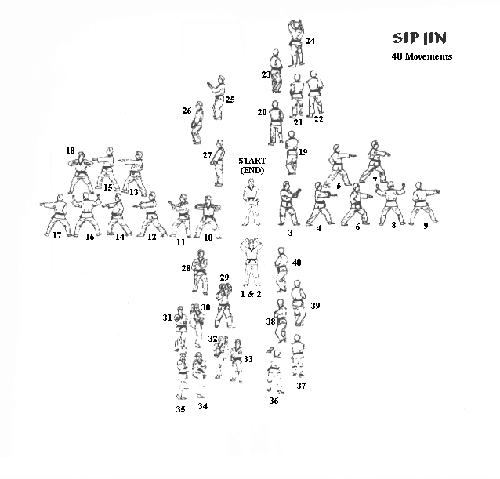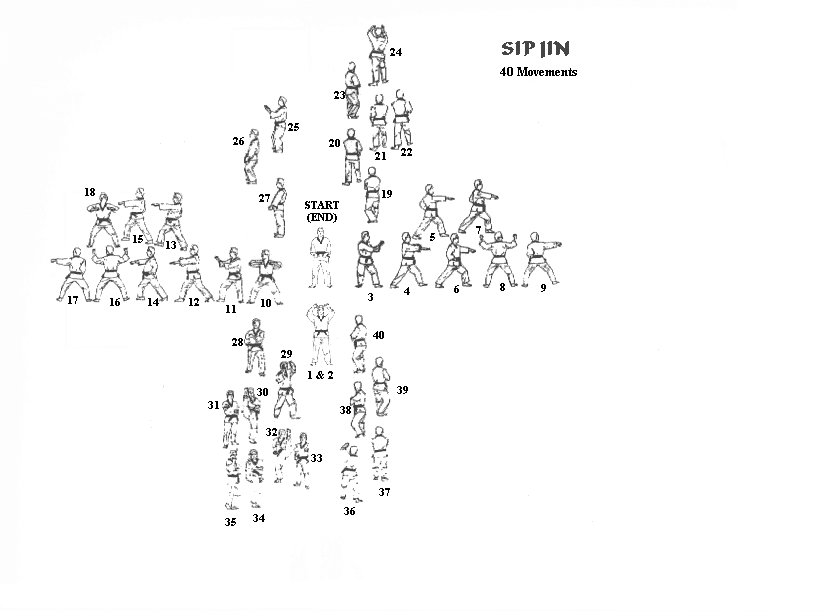TaeKwonDo Black Belt Form Sipjin is the 5th black belt test you will take as you continue to go up the ladder in learning your Tae Kwon Do black belt forms. The Sipjin Black Belt form in Tae Kwon Do is to be practiced and mastered by 5th Dan Black Belters in order to showcase their lessons, skills, and progression in Tae Kwon Do; this generally takes up to 5-6 years before getting to this level!
There are traditionally 40 steps in this form, depending on how its counted but I have condensed them into 25 as it seemed a bit easier to learn it this way.
History of Black Belt Form 5
The word “sipjin”was derived from the thought of 10 longevity, which advocates there are ten creatures of long life, namely, sun, moon, mountain, water, stone, pine tree, herb of eternal youth, tortoise, deer, and crane. They are two heavenly bodies, 3 natural resources, two plants and 3 animals, all giving human beings faith, hope and love.
The poomsae sipjin symbolizers those things.
Categories of Poomsae (Forms)
The poomsae are categorized by the technique, composition and points of stress, which are classified each into 3 minor breakdowns.
1. Technique – The technique means the technical patterns of the entire poomsae. The essence of Taekwondo is the martial art; therefore, the categorization of practicable patterns of techniques is important.
a) Poomsae containing various techniques – This contains more techniques of kicks and blocks than are needed for practical use. Practicable techniques must be selected among them in the course of training.
b) Poomsae containing practicable techniques – This includes practically used techniques only, which are classified into a series of kicking techniques, a series of blocks techniques and a balanced combination of kicks and blocks techniques.
c) Poomsae containing simple techniques – This is classified into the basic course and the advanced course, in the advanced course, the training of cultivating the inner strength of body by means of controlling the respiration is included. The variations of techniques should be mastered through hard training.
2. Composition – The composition of poomsae movements is differentiated according to the proportion of poom and technique, hand techniques and foot techniques, and stance and its moving directions. Except for certain special cases, the poomsae movements are equally distributed among all parts of the body symmetrically between fore and back and between left and right. Therefore, the proportion of foot techniques and hand techniques is the criteria to decide the composition of poomsae movements.
a) Poomsae with the priority on hand techniques
b) Poomsae with the priority on foot techniques
c) Poomsae in which hand techniques and foot techniques are evenly distributed.
3. Points of Stress – The poomsae is also classified by the extent of emphasis in favor of either strength or softness and of either a slow movement or a fast movement. Strong but slow movements and speedy but soft movements are included in the similar categories.
a) Strong but slow poomsae
b) Weak but speedy poomsae
c) Poomsae well balanced in strength and weakness as well as in slowness and speediness.
Term Used with Black Belt Form 5:
- Joon Bi Seogi– Ready Stance (i.e. “at ease”)
- KiHap – Shout
- Poomsae – Form
- Hwang So Mahki – Bull Block
- Dwi Sohgi- Back Stance
- Batagson Montong Maki – Pressing Down Block
- Kwan Soo – Horizontal Spear hand
- Ahp Aohgi – Front Stance
- Wen Apkkoa Seogi – Left Forward Cross Stance
- Juchoom Sohgi – Horse Riding Stance
- Santeul Mahki – Mountain Block
- Oreun Apkkoa Seogi – Right Forward Cross Stance
SipJin Form Step by Step
Step 1:
From your Joon Bi Seogi, execute a Bull Block and then turn left and get into a Right Back Stance.
Step 2:
Execute a right Batagson Montong Maki and slowly open your left fist and execute right Horizontal Spearhand as you slide into Left Front Stance.
Step 3:
Deliver two alternate, consecutive middle punches starting with your left fist and turn 90 degrees to your left.
Step 4:
Get into Horse-riding Stance as you look right and execute a Mountain Block and get into Wen Apkkoa Seogi.
Step 5:
Grab the opponent with your left hand and get into Oreun Apkkoa Seogi, then shift to Horse-riding stance, look right, deliver a right side punch, yell, and then turn 180 degrees to your left.
Step 6:
Execute Double Elbow Strike and get into your Left Back Stance.
Step 7:
Get into a Right Back Stance.
Step 8:
Execute a left Batagson Montong Maki and slowly open your right fist and execute left Horizontal Spearhand as you slide into Right Front Stance.
Step 9:
Deliver two alternate, consecutive middle punches starting with your right fist and turn 90 degrees to your right.
Step 10:
Get into Horse-riding Stance as you look left and execute a Mountain Block and get into Oreun Apkkoa Seogi.
Step 11:
Grab the opponent with your right hand and get into Wen Apkkoa Seogi, then shift to Horse-riding stance, look left, deliver a left side punch, yell, and then turn 180 degrees to your right.
Step 12:
Execute right Palm-Augmented Outward Block, executed by blocking your middle with an open hand and palms facing downward, as you get into your Left Back Stance.
Step 13:
Slowly open your left fist as you slide into Front Stance and deliver left Horizontal Spearhand followed by two alternate, consecutive middle punches starting with the right fist, and then get into your Right Back Stance.
Step 14:
Execute a Double Knifehand Low Block and then step into your Right Front Stance.
Step 15:
Deliver a Right Boulder Push by opening your palms and pushing both hands diagonally upward, then go to your Horse-riding Stance looking forward.
Step 16:
Execute a Right Ridgehand Opening Block by blocking as you would normally but instead of having your hand in a fist, open it with your thumb slightly tucked into your palm, then transition into a Slow Knifehand Opening Block.
Step 17:
Straighten your legs and close your fists and then turn 90 degrees to your left.
Step 18:
Move into Left Front Stance and then execute a right Boulder Push.
Step 19:
Deliver a Right Front Kick and land your leg in a Right Front Stance while you deliver a Simultaneous Punch which is basically punching with both fists at the same time.
Step 20:
Deliver a Right Front Kick then get into Oreun Apkkoa Seogi and deliver a right High Backfist Strike by aiming high and punching your fist and getting your backhand to make contact with your opponent’s head first. Then, move into Left Front Stance.
Step 21:
Get into Left Front Stance and execute a right Boulder Push and then get into your Left Tiger Stance.
Step 22:
Execute a low Cross Knifehand Block, which is essentially just forming an X with both arms in front of your face, and then get back into your Left Back Stance.
Step 23:
Execute a Ridgehand Block and step forward once with your left foot.
Step 24:
Get into your Right Back Stance and deliver a Simultaneous Punch and follow through by stepping forward with the right foot.
Step 25:
Get into your Left Back Stance, deliver a Simultaneous Punch, and then wait until you can turn back to your Joon Bi Seogi.



